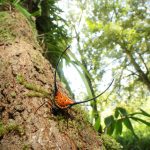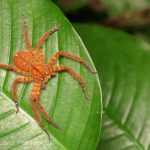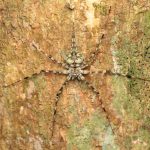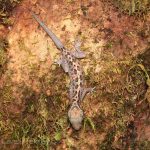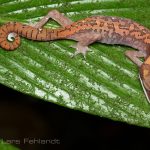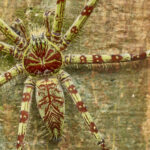Long horned orb weaver – Macracantha arcuata (Fabricius, 1793) – Syn.: Gasteracantha arcuata
Probably no other spider than Macracantha arcuata has such long outgrowths on the abdomen. It is hypothesized that this peculiar shape confuses the bats and as a result this spider is not seen as food, but rather as a kind of leaf or twig.
The spider was described in 1793 by Johann Christian Fabricius as Aranea arcuata. In 1837 Carl Ludwig Koch assigned it to the genus Gasteracantha. Eugène Simon established the genus Macracantha for this species in 1864, later it was relegated to the genus Gasteracantha as a subgenus, but in 1974 Emerit elevated it back to the genus. This genus has only one species and is therefore monotypic.
The spider was already depicted by Ernst Haeckel in his work Art Forms of Nature, published between 1899 and 1904. There it is called Bogendornige Stachelspinne in reference to the art epithet arcuata (from Latin arcuatus; curved, bent). It was frequently sent to museums and collections in Europe in the 19th century because of its bizarre appearance. Because of its strongly chitinized abdomen it did not have to be sent as a liquid preparation in spirit like the other spiders, but could be prepared dry like the beetle collections.
